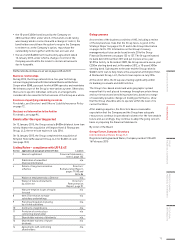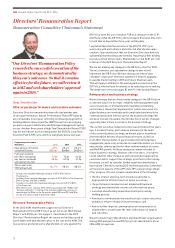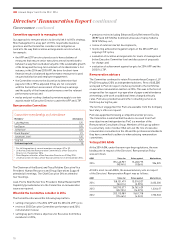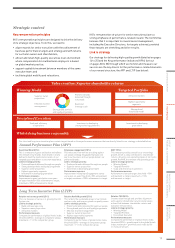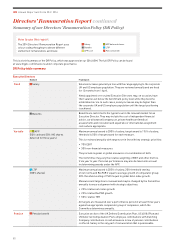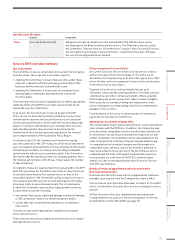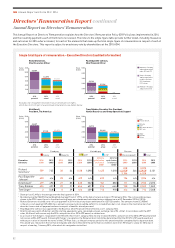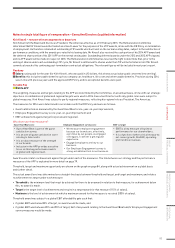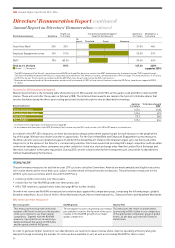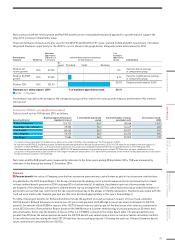Holiday Inn 2014 Annual Report Download - page 78
Download and view the complete annual report
Please find page 78 of the 2014 Holiday Inn annual report below. You can navigate through the pages in the report by either clicking on the pages listed below, or by using the keyword search tool below to find specific information within the annual report.
DR Policy were the use of relative TSR as a measure in the LTIP,
and the fact that the DR Policy did not require Executive Directors
to hold shares beyond the three-year vesting date.
I explained then that the outcome of the 2011/13 LTIP cycle
was in line with performance and reflected shareholder value
creation. I also pointed out that our Executive Directors had very
substantial shareholdings and formally requiring further holding
periods seemed unnecessary. Shareholders voted 94.01 per cent
in favour of the 2013 Directors’ Remuneration Report.
We are not making any changes to the DR Policy itself for 2015.
There is, however, one substantive change to how we will
implement the DR Policy. We have introduced a three-year
clawback clause post-vesting or payment of awards, applying
to awards made relating to 2015 and future financial years.
This will apply in addition to the existing malus provision in the
DRPolicy, which allows for awards to be reduced prior to vesting.
The details are set out on pages 81 and 91 of the Annual Report.
Remuneration and business strategy
We feel strongly that we should make changes to the DR Policy in
a coherent way if it is to retain credibility with management and
serve its purpose of motivating and rewarding outstanding
performance. Reward arrangements for senior executives of a
global business are inevitably quite complicated and need to be
communicated as an intrinsic part of the business strategy. We
are keen to avoid, if possible, the introduction of ad-hoc changes,
especially where there is no link to the business strategy.
The current executive reward structure was introduced five years
ago. It includes the key performance measures at the heart
of the current business strategy; an annual plan to incentivise
and reward the delivery of good financial results, as well as
from 2013, improvements in guest satisfaction and employee
engagement; and a long-term plan to reward the delivery of strong
shareholder returns and better-than-market number of rooms
and RevPAR growth. All these measures remain relevant to
future business strategy. However, after five years, it is right to
revisit whether other measures and remuneration approaches
could even better support the strategic priorities for the coming
five years, as well as consider further questions shareholders
have raised. Therefore, during 2015, the Remuneration Committee
will revisit all aspects of the APP and LTIP to ensure they remain
fit for purpose. This will include consideration of the following:
• the mix of short and long-term incentives and what is
appropriate for different levels of senior executives;
• the performance measures most aligned with business
strategy and shareholder returns over the next five years;
• executive shareholding requirements and post-vesting
holding periods;
• how best to communicate the overall policy to senior executives
globally to ensure it helps drive performance; and
• how to further improve communication on remuneration to
shareholders, in particular the level of disclosure of targets
and outcomes.
We will consult major shareholders and shareholder organisations
during 2015 and put the new DR Policy to all shareholders at our
2016 AGM for approval.
Dear Shareholder
2014 corporate performance and incentive outcomes
Executive Director remuneration has reflected another year
of strong performance. Annual Performance Plan (APP) awards
are comparable to last year, reflecting continued good growth of
Earnings Before Interest and Tax (EBIT) as well as encouraging
progress on guest satisfaction and Employee Engagement survey
scores. Another three years of high Total Shareholder Return (TSR)
was the main driver for the vesting under the 2012/14 Long Term
Incentive Plan (LTIP) cycle, which is marginally below last year.
Directors’ Remuneration Policy
At the 2014 AGM, shareholders approved our Directors’
Remuneration Policy (DR Policy), as set out in our 2013 Annual
Report, with 90.94 per cent support. I mentioned in the 2013
Directors’ Remuneration Report the issues we had discussed at
some depth with shareholders prior to the vote at the AGM. The
two we know prompted some shareholders to vote against the
Corporate performance
indicators 2014 2013 2012
Operating profit before
exceptional items
-2.5%
$651m1
+10.4%
$668m2
+10.4%
$605m3,4
Full-year dividend
per share(excluding
any special dividends
and capital returns)
77.0¢
48.6p
70.0¢
43.2p
64.0¢
41.2p
Three-year total
TSR (annualised) +31.7% +18.4% +28.2%
1 Includes two liquidated damages receipts in 2014: $7m, both in
The Americas.
2 Includes three liquidated damages receipts in 2013: $31m in The Americas,
$9m in Europe and $6m in AMEA.
3
Includes one significant liquidated damages receipt in 2012 of $3m
in The Americas.
4
With effect from 1 January 2013, the Group adopted IAS 19 (Revised)
‘Employee Benefits’ resulting in the following additional charges to
operating profit: $5m for the six months ended 30 June 2012 and $9m
for the 12 months ended 31 December 2012.
“ Our Directors’ Remuneration Policy
rewards the successful execution of the
business strategy, as demonstrated by
this year’s outcomes. So that it remains
eective for the future, we will review it
in 2015 and seek shareholders’ approval
again in 2016.”
Remuneration Committee Chairman’s Statement
IHG Annual Report and Form 20-F 2014
76
Directors’ Remuneration Report











